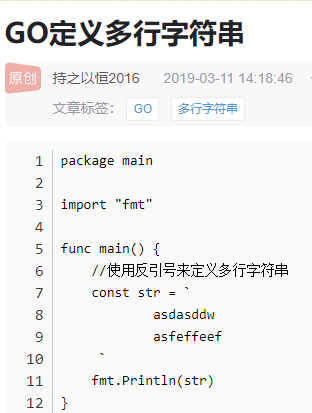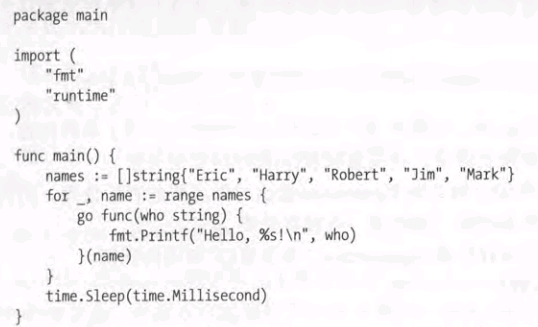go常用命令
1、字符串和int之间相互转换
string转成int:
int, _ := strconv.Atoi(string)
string转成int64:
int64, _:= strconv.ParseInt(string, 10, 64)
int转成string:
string := strconv.Itoa(int)
int64转成string:
string := strconv.FormatInt(int64,10)
2、接口转字符串
比较粗暴的方法:str := fmt.Sprintf("%v", v)
或者:
func Strval(value interface{}) string {
// interface 转 string
var key string
if value == nil {
return key
}
switch value.(type) {
case float64:
ft := value.(float64)
key = strconv.FormatFloat(ft, 'f', -1, 64)
case float32:
ft := value.(float32)
key = strconv.FormatFloat(float64(ft), 'f', -1, 64)
case int:
it := value.(int)
key = strconv.Itoa(it)
case uint:
it := value.(uint)
key = strconv.Itoa(int(it))
case int8:
it := value.(int8)
key = strconv.Itoa(int(it))
case uint8:
it := value.(uint8)
key = strconv.Itoa(int(it))
case int16:
it := value.(int16)
key = strconv.Itoa(int(it))
case uint16:
it := value.(uint16)
key = strconv.Itoa(int(it))
case int32:
it := value.(int32)
key = strconv.Itoa(int(it))
case uint32:
it := value.(uint32)
key = strconv.Itoa(int(it))
case int64:
it := value.(int64)
key = strconv.FormatInt(it, 10)
case uint64:
it := value.(uint64)
key = strconv.FormatUint(it, 10)
case string:
key = value.(string)
case []byte:
key = string(value.([]byte))
default:
newValue, _ := json.Marshal(value)
key = string(newValue)
}
return key
}
3、go定义多行字符串
4、定义一个map
var num = map[string]int{"I": 1, "V": 5, "X": 10, "L": 50, "C": 100, "D": 500, "M": 1000}
5、居然有copy命令和排序命令func merge(nums1 []int, m int, nums2 []int, n int) {
copy(nums1[m:], nums2)
sort.Ints(nums1)
fmt.Println("======nums1:", nums1)
}6、str := fmt.Sprintf()用来输出字符串
Go 可以使用 fmt.Sprintf 来格式化字符串,格式如下:
s := fmt.Sprintf("%s is %d years old.\n", name, age)
7、针对转义符的处理不同,printf()函数会将输入参数中的%d类型的值进行带入,但是fmt.Println不会
8、数组的range
for i in range list:
i是序号
for index, value in range list:
index 和value
9、go 输出table
https://github.com/jedib0t/go-pretty/tree/main/table
10、命令行的入参可以采用os.Args变量;
命令行的开关可以采用flag
11、go的块注释和c语言的块注释一样
/*
*/
12 go语言定义变量的时候,支持多变量一起定义:
var v1 int
var v2 int 可以合并:
var (
v1 int
v2 int
)
13 go提供多重赋值功能
i,j = j, i
python也支持
14、import _ "fmt"
下划线的意思是说,只调用fmt的init函数,无法使用fmt包中的变量和函数, 所以上述程序错误。
15、通过const关键字赋值,可以不用带类型
const zero = 0.0
const u float32 = 0 //u=0.0
16、 系统默认推导64为int类型
var value 2 int32
value1 := 32
value2 = value1 //编译错误
value2 = int32(value1) //编译正确
系统默认推导64.0为float64类型
var value 2 float32
value1 := 32.0
value2 = value1 //编译错误
value2 = float32(value1) //编译正确
17、***go里面的数组是值类型,在进行赋值和作为参数传递时,会进行一次复制操作。
所以作为入参的时候,函数里的值发生改变了,不会影响函数外的值。
18、切片
- 元素个数
- 存储空间
- 切片时指向数组的指针
切片创建的方法:
1、var mySlice []int=myArray[:5]
2、mySlice1 := make([]int,5) mySlice1 := make([]int,10)
3、mySlice1 := []int{1,2,3,4,5}
cap(mySlice)切片分配的空间大小
len(mySlice)当前所存储的元素个数
19 append
myslice = append(myslice, 1,2,3)
myslice = append(myslice, myslice1...)
20、copy()介绍
slice1 := []int{1,2,3,4,5}
slice2 := []int{5,4,3}
copy(slice2, slice1) //复制slice1前面三个元素到slice2中
copy(slice1, slice2) //复制slice2到slice1的前三个元素
21、person, ok = personDB["123"]
if ok {
//存在
} else {
//不存在
}
22、go map删除
delete(myMap, "1234")
1、如果123,不存在,不影响,不报错;
2、如果myMap时nil,则panic抛出异常;
23、go的跳转语句
goto
24、不定参数的利用
func myfunc(args ...int){
for _,arg := range args{
fmt.Println(arg)
}
}
...type实际上是一个切片,这样做的好处是省去了定义一个结构[]int{}
25、defer是先进后出的原则,有点像堆
26、panic和recover
panic直接报错,退出,例如:panic(404)
recover用于恢复错误的流程。比如panic后,直接退出,但是采用recover可以实现捕获,然后继续运行。例如:
def func() {
if r:=recover();r != nil{
log.Printf("Runtime error caught: %v", r)
}
}
涉及到def的传参:https://www.cnblogs.com/nulige/p/10233200.html
27、go可以给任意类型增加相应的方法: 这样处后,a就是一个新的类型,又是整数,有带有方法
type Interger int
fun (a Intergert) Less(b Interger) bool{
return a < b
}
func main() {
var a Integer = 1
if a.Less(2){
fmt.Println(a, "Less 2")
}
}
28go的引用:
var a = [3]int{1,2,3}
b := &a
b[1]++
fmt.Println(a, *b)
29、go中结构体相当于类,同样会有继承
type Base struct{
Name string
}
fun (base *Base) Foo(){
...
}
30、如果是小写的变量,只能在同一个包级别访问
31、channel的声明
var ch chan int
channel的定义:
ch := make(chan int)
ch <- value
value :=<-ch
32、可以用select来进行超时的限制。
33、设置go并发数;
runtime.GOMAXPROCS(cpu核心数目)
runtime.NumCPU()获取的是宿主机的核心数34、go提供了两种锁的类型: sync.Mutex和sync.RWMutex
典型的用法:
var l sync.Mutex
fun fool(){
l.Lock()
def l.Unlock()
//...
}
35、go的全局只执行一次 sync.Once
36 json字符串转其他类型 以及 其他类型转json字符串
import"encoding/json"json字符串转其他类型
字符串或者[]bytes转列表、结构体、
s = `[1, 2, 3, 4]`
vara []int
// 将字符串反解析为数组
json.Unmarshal([]byte(s), &a)
fmt.Println(a)// [1 2 3 4]type User struct {
Id int `json:"id"`
Name string `json:"name"`
}var user User
// 将字符串反解析为结构体
json.Unmarshal([]byte(s), &user)
fmt.Println(user) // {1 wxnacy}参考:https://blog.csdn.net/learn8more/article/details/103592844
其他类型转字符串
b,err := json.Marsha1(book)
37、go并发




